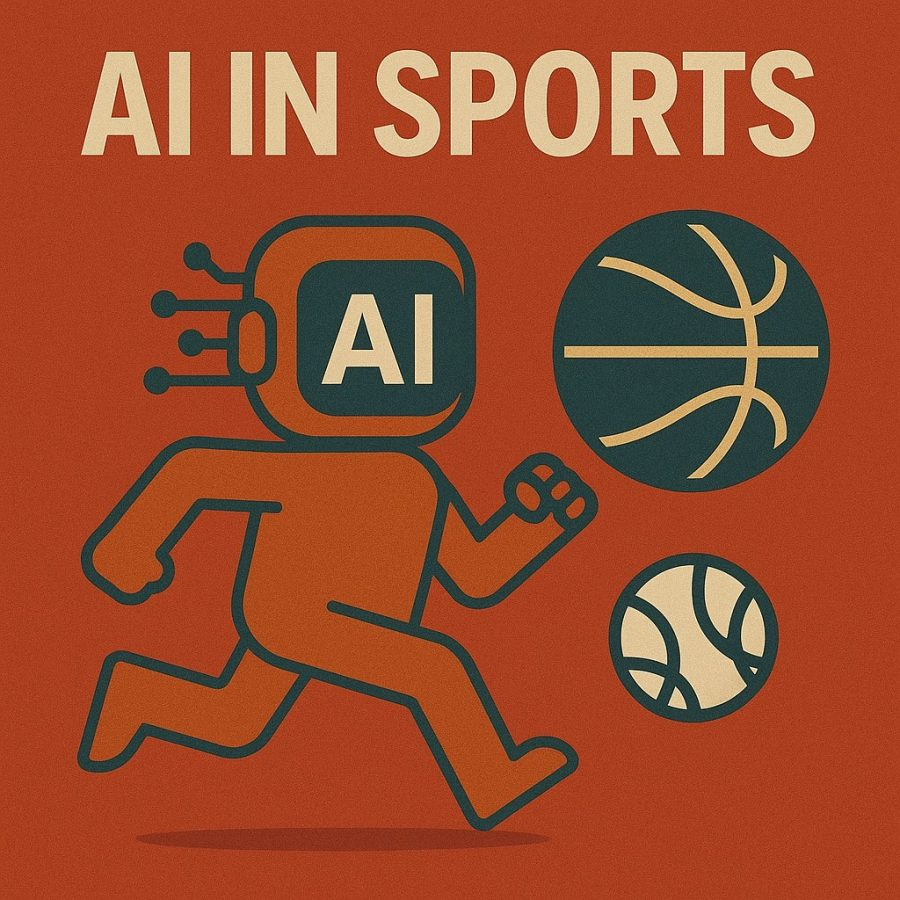Views: 3
It is not the roar of the crowd, the crunch of cleats on turf, or the swish of the net that defines modern sports anymore. Increasingly, it is the quiet hum of algorithms running in the background. This AI in Sports: From Performance Tracking to Referee Bots article digs deep into how artificial intelligence has shifted from a side experiment in fitness apps to the backbone of elite performance, broadcasting, fan engagement, and even officiating.
Spend a few minutes with the latest sports broadcasts and you’ll notice the subtle fingerprints of machine learning everywhere. Shot-tracking overlays in tennis. Win-probability graphics in football. AI commentary assisting play-by-play. And behind the scenes, systems that predict injuries before they happen or recommend tactical changes mid-match. Sports are not just faster and stronger; they are now smarter.
The rise of AI in sports is not simply about gadgets and buzzwords. It is about shifting the balance between tradition and technology, between instinct and prediction, between human error and machine precision. After 5,000 words, you’ll see why this transformation matters for athletes, coaches, fans, and yes, even referees whose whistles may someday be replaced by bots.
A Short History of AI in Sports
The story of AI in Sports: From Performance Tracking to Referee Bots begins in the weight rooms of the early 2000s, where basic motion sensors tracked lifts and runs. These systems were crude by today’s standards but opened the door to data-driven training.
By the 2010s, machine learning models were being tested in professional sports. Soccer teams used early AI analytics to study passing patterns.
Baseball embraced sabermetrics, with predictive modeling influencing recruitment and lineup choices. AI scouting tools crept into the NBA, identifying undervalued players who fit team systems.
The 2020s brought the explosion: AI vision tracking in real time, wearable sensors crunching biometric data, and natural language systems that translated those insights into coaching advice.
Now in 2025, we are standing at a point where refereeing, injury prediction, tactical planning, and even fan experiences are being reshaped by artificial intelligence.

Sports Research® Vitamin D3 + K2 w/ Coconut Oil – Vegan Vitamin D 5000iu & Mk7 Vitamin K 100mcg for Bone & Immune Support – Vegan Certified · Non-GMO · Soy Free – 60 Softgels
Performance Tracking: The Athlete’s Digital Twin
If you ask any coach what keeps them up at night, it is not just injuries or bad calls—it is uncertainty. How much can a player run before fatigue turns into a pulled muscle? Is that free throw form consistent enough under pressure? Can training loads be optimized without overtraining?
Enter AI-based performance tracking.
Wearables and Sensors
Modern wearables go beyond steps and heart rates. Chest straps, smart cleats, and AI-powered patches capture acceleration, blood oxygen, hydration, and micro-muscle fatigue. Combined with machine learning, these devices build a digital twin of the athlete—an evolving model that simulates performance and predicts outcomes.
Video-Based Analytics
Systems like Hawk-Eye in tennis and SportVU in basketball track every motion of the ball and the players. AI algorithms then overlay predictive analytics: who is most likely to receive the next pass, where the shot success probability is highest, and which defensive breakdown is imminent.
Injury Prevention
Perhaps the biggest win from AI in sports performance tracking is injury forecasting. By analyzing gait, workload, and biomechanics, AI systems warn trainers when an ACL tear risk spikes or when a pitcher’s shoulder is nearing red-line strain. These warnings save millions in sidelined salaries and give players longer careers.
In essence, AI turns the guesswork of coaching into probability-driven decisions, backed by terabytes of live data.
Strategy and Game Planning
Sports are war by another name, and in war, intelligence wins. AI in sports strategy goes far beyond reviewing tape.
- Pattern Recognition: AI tools analyze hundreds of hours of footage to find subtle patterns—like a quarterback favoring one receiver on third down or a tennis player defaulting to backhand slices under pressure.
- Opponent Prediction: Teams can feed scouting data into predictive models that simulate likely plays or formations. In soccer, AI predicts where an opponent’s attack will funnel through. In baseball, it forecasts pitch selection with eerie accuracy.
- Tactical Adjustments: Mid-game, AI tools suggest formation tweaks based on live data. Some soccer teams already adjust pressing intensity in real time, guided by algorithmic insights.
Fans often credit coaches for brilliant tactical shifts. Increasingly, those shifts are nudged or outright dictated by machine learning.

Referee Bots: Fairness or Friction?
Now we come to the most controversial part of this AI in Sports: From Performance Tracking to Referee Bots story: officiating.
Human referees have always been lightning rods for criticism. From Diego Maradona’s “Hand of God” to blown calls in Super Bowls, fans and players alike question the fairness of officiating. AI promises to fix that.
VAR and Beyond
Video Assistant Referee (VAR) in soccer was the first taste of semi-automated officiating. But VAR still relies on humans interpreting video. AI refereeing goes further, using computer vision to detect fouls, offsides, or line calls instantly.
Tennis and Baseball Pioneers
Tennis led the way with Hawk-Eye, replacing line judges in many tournaments. Baseball is testing automated strike zones, with AI-powered umpiring systems calling balls and strikes more consistently than humans.
The Human Factor
Of course, fans argue that sports need the “human element.” AI referees may be accurate, but will they rob sports of drama? Imagine a World Cup decided not by a referee’s whistle but by a cold algorithm blinking red. Fair? Yes. Thrilling? That is up for debate.
The future likely lies in hybrids: referees augmented by AI, reducing errors while maintaining the perception of human fairness.
AI in Broadcasting and Fan Engagement
AI in sports is not just for players and coaches; it is changing how fans consume games.
- AI Commentary: Natural language models generate live match commentary, translating broadcasts into dozens of languages instantly.
- Personalized Highlights: AI cuts together highlight reels tailored to your favorite player or team, delivered minutes after a game ends.
- Fan Predictions: Apps gamify sports by letting fans make AI-powered predictions, integrating betting with live analytics.
- Augmented Reality: In-stadium fans use AR glasses to see real-time stats floating over players.
This personalization makes fans feel closer to the game while giving broadcasters new revenue streams.

Sports Research Collagen Peptides for Women & Men, Unflavored, 16 oz., Hydrolyzed Type 1 & 3 Collagen Powder Protein Supplement for Healthy Skin, Nails, Bones & Joints. Over 138k sales to date.
Economics of AI in Sports
Behind every AI sensor and referee bot is money. The economic impact of AI in sports is staggering.
- Cost Savings: Injury prevention and performance optimization reduce wasted salaries and rehab expenses.
- Revenue Growth: AI-enhanced broadcasts draw larger audiences and advertising dollars.
- Data Monetization: Player data is sold to analytics companies, fantasy leagues, and betting firms.
However, this raises ethical questions: who owns an athlete’s biometric data? Should leagues profit from data captured from their players’ bodies? The debate is only beginning.
Case Studies Across Sports
Soccer
Clubs like Manchester City and FC Barcelona use AI to analyze passing lanes and predict injuries. FIFA has integrated semi-automated offside detection powered by AI vision.
Basketball
NBA teams use AI-based SportVU cameras to track every movement. Coaches receive real-time heat maps of player efficiency, while broadcasters use AI to create new viewing angles.
Baseball
AI in baseball is revolutionizing scouting and umpiring. Automated strike zones are being tested, while recruitment relies heavily on predictive models for minor-league players.
American Football
NFL teams use AI to analyze playbooks, predict defensive schemes, and minimize concussion risks by tracking impacts with helmet sensors.
Tennis
Hawk-Eye’s AI has essentially eliminated line judges in top tournaments, offering millimeter accuracy and speeding up matches.
Referee Bots vs Human Referees
| Aspect | Human Referees | AI Referee Bots |
| Decision Speed | Seconds to minutes (reviews, discussions) | Instant judgments via computer vision |
| Accuracy | Influenced by angle, fatigue, and pressure | Millimeter precision on offsides, line calls, or strike zones |
| Consistency | Varies across officials and games | Uniform across competitions |
| Fan Drama | High (debate and controversy) | Lower (calls are rarely disputed) |
| Trust Factor | Tradition, emotional connection | Technology, requires cultural acceptance |
The Psychology of AI in Sports
Athletes are not robots. Introducing AI into training and officiating alters their psychology.
- Trust Issues: Some players resist AI injury predictions, believing in their own resilience.
- Motivation: Constant tracking can feel like surveillance, creating pressure.
- Confidence Boosts: Others thrive, knowing their load is optimized and injury risks minimized.
The psychological impact is as important as the physical, and coaches must balance technology with human intuition.

Ethical Dilemmas
This AI in Sports: From Performance Tracking to Referee Bots review would be incomplete without addressing ethics.
- Data Privacy: Should an athlete’s biometric data be sold or locked down as private property?
- Over-Reliance: Will teams lose creativity if they blindly follow AI-driven strategies?
- Fan Fairness: If referee bots eliminate human error, will fans lose the joy of debating controversial calls?
Sports thrive on drama. AI reduces chaos. The balance between precision and passion is delicate.
Looking Ahead: The Future of AI in Sports
The trajectory is clear. By 2030, expect:
- Fully automated officiating in tennis, baseball, and soccer offsides.
- AI wearables integrated directly into uniforms, invisibly tracking every player.
- Coaches using VR simulations powered by AI predictions to rehearse games.
- Fans watching hyper-personalized broadcasts with AR overlays and instant translations.
The ultimate vision? Sports where humans still play but AI ensures every action is measured, analyzed, and optimized in real time.
AI in Sports, Love It or Hate It
The verdict on AI in Sports: From Performance Tracking to Referee Bots is both thrilling and unsettling. On one hand, AI prevents injuries, improves fairness, and enhances fan experiences. On the other, it raises questions about privacy, drama, and authenticity.
In many ways, sports mirror life: unpredictable, messy, and imperfect. AI tries to sand away those imperfections. Whether fans will embrace that sanitized version or rebel against it will shape the next decade.
One thing is certain: AI is no longer a sideshow in sports. It is the main event, and the whistle has already blown.


